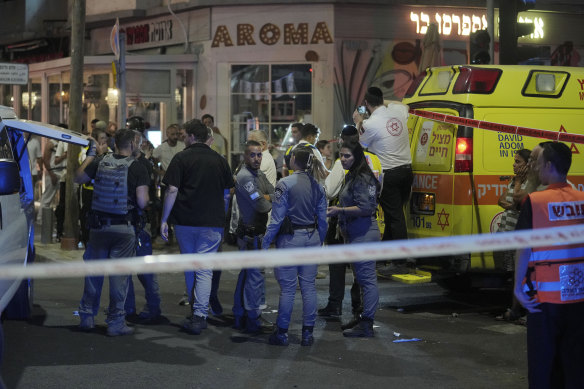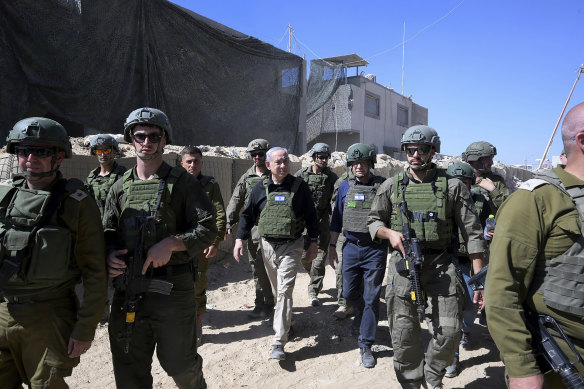Tel Aviv hit by drone attack claimed by Iranian-backed Houthis
By Ami Bentov
Tel Aviv: Yemen’s Houthi rebels have claimed responsibility for an early morning drone strike that hit a part of central Tel Aviv near the United States Embassy, leaving at least 10 injured and one dead.
The aerial strike rumbled through the streets causing shards of shrapnel to rain down and spreading shards of glass over a large radius. The Houthis have repeatedly launched drones and missiles toward Israel throughout the nine-month-long war, in solidarity with the Palestinian people and against Israel. But until Friday, all were intercepted by either Israel or Western allies with forces stationed in the region.

Israeli police and first responders gather at the scene of a deadly explosion in Tel Aviv.Credit: AP
The attack on Tel Aviv is likely to fan fears about further fallout from the Gaza war, as the Houthis and other Iranian proxies side with the Palestinian militant group Hamas. Yahya Sare’e, the Houthis’ spokesperson, said in a statement published on the social media platform X that the strike was made in retaliation to the war and had hit one of many of the group’s targets.
The Houthis claimed that their newest drones can bypass Israel’s aerial defence systems. However, a spokesperson for Israel’s military said that the explosive-laden drone had been identified and attributed the hit to “human error.” The military’s assessment of aerial threats has not changed because, the military said, Israel’s adversaries have attempted such strikes for months.
“It was a terror attack that was targeted to kill civilians in Israel,” the Israeli spokesperson said.
The Houthi strike hit hours after Israel’s military confirmed one of its airstrikes had killed a Hezbollah commander and other militants in southern Lebanon. Israel has so far not made attacks on the Houthis, allowing its allies instead to take the lead as it focuses its efforts on the war in Gaza and ongoing fighting with Lebanon’s Hezbollah militant group.
It comes as international mediators continue to hold out hope for a ceasefire agreement, pushing Israel and Hamas toward a phased deal that would halt fighting and free about 120 hostages held by the militant group in Gaza.

Prime Minister Benjamin Netanyahu, centre, walks with Israeli forces during a surprise visit to the southern city of Rafah.Credit: Avi Ohayon/Israel Prime Minister’s Office via AP
The prospects a deal could improve as Israeli leaders signal their operation underway in Rafah is close to finished. Benjamin Netanyahu made a surprise visit to troops in southern Gaza on Thursday, saying it was essential that Israel keep control of a strip of territory along the territory’s border with Egypt.
However, fears of potential escalation resurfaced on after Israel’s far-right national security minister, Itamar Ben-Gvir, visited Jerusalem’s most sensitive holy site on Thursday to pray for the return of Israeli hostages, he said, “without a reckless deal, without surrendering.”
Local police in Tel Aviv said that the Friday blast sounded at around 3:10 am (Tel Aviv time), reverberating to nearby cities and physically injuring at least 10 people. Tel Aviv District Commander Peretz Amar said officers could not locate the point of contact, suggesting the explosion occurred in the air.

People are seen through a broken coffee shop window next to the scene of an explosive drone attack in Tel Aviv.Credit: AP
“The force of the explosion caused damage that is not great but is spread over a large area. At the moment we don’t know what the object was,” Amar said.
Israel possesses a multilayered aerial defence system, capable of intercepting threats ranging from long-range ballistic missiles to drones and short-range missiles. These systems have intercepted thousands of projectiles throughout the war. But officials warn they are not 100 per cent effective, and the systems appear to have struggled against small and hard-to-detect attack drones. It was not known which, if any, system was deployed.
Like Hamas, Hezbollah and the Houthis are backed by Israel’s arch enemy, Iran. Israel for the most part also has avoided a direct confrontation with Iran throughout the war. Iran launched hundreds of drones and missiles at Israel during a single incident in April in response to Israel’s alleged assassination of a pair of Iranian generals in Syria at the time.
The war in Gaza, which was sparked by Hamas’ October 7 attack on southern Israel, has killed more than 38,600 people, according to the territory’s Health Ministry, which does not distinguish between combatants and civilians in its count. The war has created a humanitarian catastrophe in the coastal Palestinian territory, displaced most of its 2.3 million population and triggered widespread hunger.
Hamas’ October attack killed 1200 people, mostly civilians, and militants took about 250 hostage. About 120 remain in captivity, with about a third of them believed to be dead, according to Israeli authorities.
AP
Get a note directly from our foreign correspondents on what’s making headlines around the world. Sign up for our weekly What in the World newsletter.